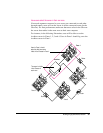
Now that you have made the server’s physical connection to LocalTalk, you
can start up the server.
IMPORTANT
After connecting to a LocalTalk network (if you have not also
connected to Ethernet), each time you start up the server you’ll see a dialog
box that indicates an error condition. This dialog box informs you that the
system has made a temporary switch from EtherTalk (its preset network
software connection) to LocalTalk. You will see this message until you change
the default setting in the AppleTalk control panel. Turn to Chapter 2,
“Configuring Your Network Connection” in the Work gr o up Server
Administrator’s Guide to learn how to switch the setting in the AppleTalk
control panel.
Building a high-performance network
Your Workgroup Server 8550 is designed to support a multisegment, high-
performance network. Connection devices such as repeaters, bridges, routers,
and gateways extend network segments and provide efficient links between a
variety of network segments. For information about extending and connecting
AppleTalk networks, see Planning and Managing AppleTalk Networks (an Apple
book published by Addison-Wesley that is available at computer bookstores).
In addition to its built-in Local Talk and Ethernet ports, your server has three
expansions slots where you can install PCI cards for connecting additional
network segments, including different network types such as Token Ring,
Integrated Services Digital Network (ISDN), Fiber Distributed Data Interface
(FDDI), and Fast Ethernet (100BASE-T) networks. The multihoming
capabilities of Open Transport 1.1, the new networking and communications
software that is part of the Mac OS, make it possible for your server to access
multiple network segments at the same time.
Building a high-performance network 25


















